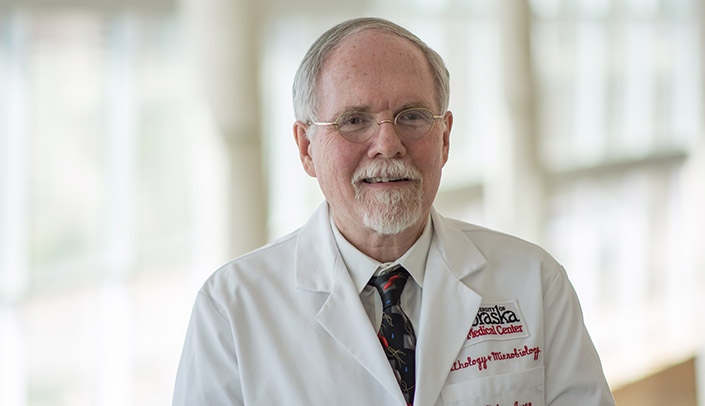Not only are technologists in the Nebraska Public Health Laboratory working overtime testing specimens for COVID-19, they also are making test processes more efficient and safe for lab technologists across the country.
Pete Iwen, Ph.D., director of the Nebraska Public Health Laboratory and professor in the UNMC Department of Pathology and Microbiology, and his colleagues recently published two articles in the American Journal of Clinical Pathology, a major journal referenced by laboratory technologists.
One article provides biosafety instructions for laboratorians; the other focuses on the use of group testing to conserve laboratory test materials. Both articles are considered “hot topics,” having received thousands of views and downloads.
Lab personnel refer to federal and international interim guidance documents when it comes to safe handling of specimens that might contain the virus that causes COVID-19, but “it was getting confusing for the bench technologists to keep up with multiple changes on how to handle these specimens,” Dr. Iwen said. “Laboratorians don’t have time to keep up with this so we put the major safety issues into one document to provide a template for laboratorians. Yes, we’re busy, but there was a need.”
Dr. Iwen said not only is there an interest in the information in clinical labs in urban hospitals, but also in front line labs in rural hospitals.
“We recognized that many labs in Nebraska did not have the type of equipment found in bigger labs,” he said. “We wanted to provide them guidance for the equipment and other supplies, such as personal protective equipment, that they did have in their labs to keep them safe.”
The second article deals with group testing of pooled specimens, which could help alleviate the national shortage of reagents (chemicals used for testing).
“Many labs have stopped or severely limited testing for COVID-19 because of a shortage of reagents,” Dr. Iwen said. “I knew of the concept of group testing of pooled specimens and thought it might be a potential way to save on reagents, but still provide reliable results.
Dr. Iwen said they verified the process using excess specimens to create a pool, which included four negative specimens and one positive from a patient with COVID-19. “To verify that the process worked, multiple pools were made by combining one positive with four negative specimens, and the pools were subsequently tested. In all cases, the positive specimen was identified.”
